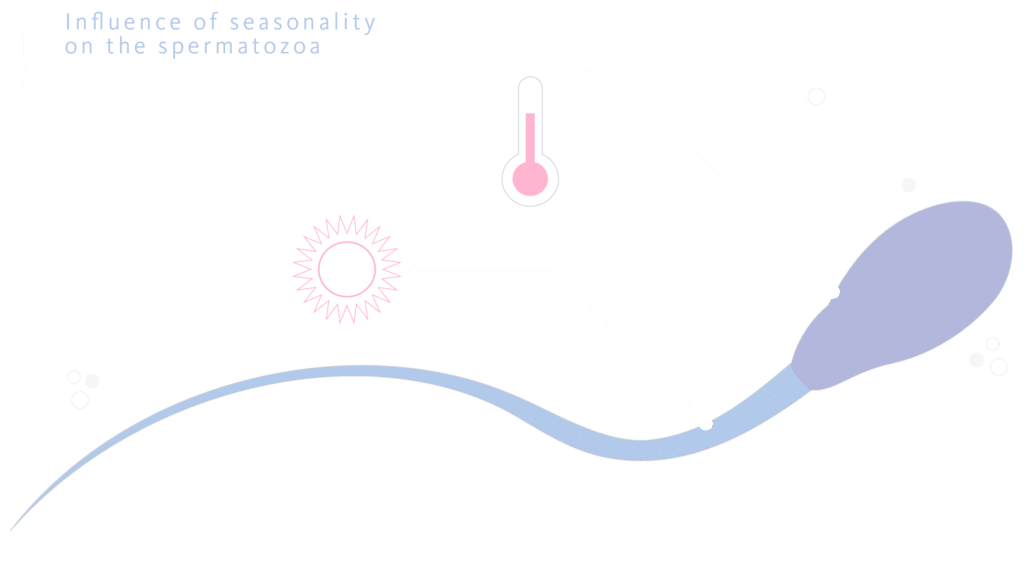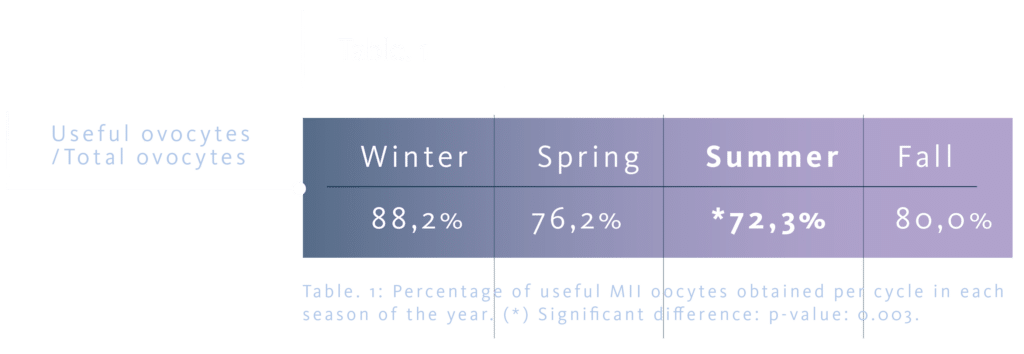Influence of seasonality on natural conception
It is known that the natural biological process of reproduction is modified according to the circadian rhythm, which produces changes at the pituitary level in the amplitude and frequency of hormonal secretion pulses involved in folliculogenesis and spermatogenesis. Seasonal differences on reproductive process in mammals and the frequency of sexual intercourse in humans have also been described (1), but the birth rate during the year is not really modified in humans by seasonal variability.
Influence of seasonality on IVF treatments
Assisted Reproductive Technologies (ART) are susceptibility to external environmental factors, overall related with gametes obtention during IVF treatments, these effects are more relevant in geographic areas with high temperature variations.
In assisted reproductive technologies, it is very important to recognize that there are two parties involved in the process, male and female gamete, for this reason it’s very important understand the different influence of the weather over each gamete. On the other hand, it’s important consider the difference of two seasonal factors: temperature and light time, because it`s probably both have influence over gametes.
The spermatozoa (male factor):
In relation with male gamete, the temperature has more influence than the light exposure.
The negative effect of exposure to high temperatures on semen quality is well known, not only from occupational exposure, but has also been documented in large studies during the summer season (2).

The oocyte (female factor):
With respect to the oocyte, there is no consensus on the influence of the seasons on the quality of the oocytes used in assisted reproductive technologies. Some studies support the theory that exposure to higher levels of melatonin, a hormone secreted during periods of darkness (mostly in months with less hours of light), has positively influences on the oocyte quality (3). On the contrary, other researchers suggest that the results of ovarian stimulation in IVF treatments are better in the months with more exposure to light (4). In general, the influence of the light exposure over the female gamete is controversial.
The research team of Gametia Group wanted to treat elucidate this incognita, for this reason studied the influence of seasonal variability in more than 500 cycles of oocyte donation, where the ovarian response is expected to be similar, since the common characteristics in this group of patients.

The response to ovarian stimulation was determinant, observing a significant decrease in the recovery of viable oocytes during the summer months (table.1). This is an important implication nowadays, because the important role of oocyte donation cycles in assisted reproductive technologies worldwide. One of the limitations of the study is that we only analyzed cycles from only one fertility center where summer temperatures could be considered extremely high, so the results should be viewed with caution.

The Main Goal: Live Healthy Baby
Regardless of the influence of environmental factors on the oocyte, the ultimate goal of assisted reproductive technologies is a healthy newborn at home.
However, the influence of external factors such as environmental temperature and light exposure, changing factors during different seasons of the year, effects on fertilization rate, embryo development, embryo implantation and evolutive pregnancy have not been conclusive either.
One of the main problems with the heterogeneity of studies is that they are conducted in different geographical areas with different climatic environments (5). A study published by the European Society of Human Reproduction, suggests that the results of in vitro fertilization are not better in the summer months (9). Also, studies conducted in the Netherlands and the United States found no differences in
If the morphokinetic data, i.e. embryo division times and events, of 1PN, 2PN and 3PN zygotes are analysed and compared, it is observed that 3PN and 2PN embryos exhibit quite similar morphokinetics. However, 1PN zygotes show a slower pace, taking a longer time to reach any stage of embryo division.
fertilization rate and embryo development, but better results in pregnancy rate after assisted reproductive treatment in the colder months (6,7).
In contrast, studies of fertilization rates and embryo development performed in Iran showed better results mainly in spring (8).
Finally, the results of more than three thousand cycles of assisted reproduction with donor oocytes in our centers showed no differences in relation to seasonality and the rate of fertilization, embryo development or pregnancy.
With these data, we can conclude that the main objective of assisted reproduction, which is to have live and healthy babies at home, is not affected by the change in seasonality, even if there is a decrease in oocyte yield in the summer months, the reason for which will have to be explained in future research.
Conclusions
Zygotes with 1 and 3 pronuclei can develop into embryos, although in a lower proportion than zygotes with 2. PGT-A, in conjunction with single nucleotide polymorphism (SNP) analysis, can effectively distinguish between euploid and non-euploid, diploid and non-diploid embryos, as well as identify the chromosomal endowment of maternal and paternal origin. Euploid embryos derived from abnormal zygotes have the potential to result in healthy gestations. Rescuing these embryos from cycles with a low number of embryos can increase the chances of gestation for these patients.
References
- Smits LJ, Van-Poppel FW, Verduin JA, Jongbloet PH, Straatman H, Zielhuis GA. Is fecundability associated with month of birth? An analysis of 19th and early 20th century family reconstitution data from The Netherlands. Hum Reprod. 1997;12:2572–8.
- Levine RJ, Bordson BL, Mathew RM, Brown MH, Stanley JM, Star TB. Deterioration of semen quality during summer in New Orleans. Fertil Steril. 1988;49:900–7.
- Yie SM, Brown GM, Liu GY, Collins JA, Daya S, Hughes EG, et al. Melatonin and steroids in human pre-ovulatory follicular fluid: seasonal variations and granulosa cell steroid production. Hum Reprod. 1995;10:50–5
- F. VandekerckhoVe, Seasons in the sun: the impact on IVF results one month later. FacTs Views Vis obGyn, 2016, 8 (2): 75-83
- Audrey j. Gaskins, The impact of temperature and relative humidity on outcomes of ovarian stimulation and in vitro fertilization using an oocyte donation cohort, 2019.
- Stolwijk AM, Reuvers MJ, Hamilton CJ, Jongbloet PH, Hollanders JM, Zielhuis GA. Seasonality in the results of in-vitro fertilization. Hum Reprod. 1994;9:2300–5.
- Farland LV, Correia KFB, Missmer SA, Racowsky C. Seasonal vari- ation, temperature, day length, and IVF outcomes from fresh cycles. J Assist Reprod Genet. 2020;37:2427–33.
- Khafri et al. Royan Institue International Journal of Fertility and Sterility Vol 2, No 2, Aug-Sep 2008, Pages: 90-95
- Carlsson Humla et al. Fresh IVF/ICSI in summer does not improve live birth rate
